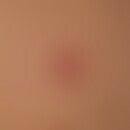DefinitionThis section has been translated automatically.
M. ulcerans is genetically very closely related to M. marinum and can only be distinguished by specific genetic analyses. However, in contrast to M. marinum, the germ does not grow or grows only very sparsely on the usual media. M. ulcerans is isolated from the skin lesions of patients with Buruli ulcer. Mycobacterium ulcerans is a toxin-producing environmental mycobacterium.
General informationsThis section has been translated automatically.
Buruli ulcer, an infection with Mycobacterium ulcerans, is an infectious disease of the skin and subcutis that has occurred in over 33 countries worldwide. It has been found not only in tropical areas such as West Africa, where it is most common, but also in areas with temperate non-tropical climates, including Australia (Bairnsdale Ulcer) and Japan. In Australia, M.ulcerans has also been detected in mosquitoes (Aedes camptorhynchus/ Johnson PD et al. 2007).
You might also be interested in
Occurrence/EpidemiologyThis section has been translated automatically.
Estimates for global incidence are not currently available, but in 2016, only ten countries reported nearly 2000 BU cases to WHO (WHO 2017).
ClinicThis section has been translated automatically.
The clinical presentation of BU is non-ulcerative or ulcerative lesions or osteomyelitis occurring mainly in the limbs. Up to 22% of BU patients develop permanent functional sequelae, including amputations, which is associated with severe BU (with large lesions, edema, osteomyelitis, or multifocal lesions).
The disease is classified by WHO into three categories depending on the severity:
- Category I, when the patient has a small lesion with a size < 5 cm,
- Category II, when the patient has non-ulcerative or ulcerative plaques, edema, or a large lesion with a maximum diameter between 5 and 15 cm
- Category III if he has disseminated or mixed forms, multiple lesions, or a large lesion with a diameter of > 15 cm (WHO 2017).
LiteratureThis section has been translated automatically.
- Abdoulaye S et al (2014) Mycobacterium ulcerans Disease with Unusual Sites Not to Be Ignored. Dermatol Res Pract 2014:639374.
- Dallmann-Sauer M et al (2018) Human genetics of mycobacterial disease. Mamm Genome 29:523-538.
- Griffith DE et al (2007) Am J Respir Crit Care Med 175: 367-416.
- Johnson PD et al (2007) Mycobacterium ulcerans in mosquitoes captured during outbreak of Buruli ulcer, southeastern Australia. Emerg Infect Dis 13:1653-1660.
- Sizaire V et al (2006) Mycobacterium ulcerans infection: control, diagnosis, and treatment. Lancet Infect Dis 6:288-296.
- WHO (2017) Buruli ulcer (Mycobacterium ulcerans infection) - Fact sheet No 199. http://www.who.int/mediacentre/factsheets/fs199/en/. Accessed 15 Feb 2018.
- WHO (2017) Number of new cases of Buruli ulcer reported: 2016. http://apps.who.int/neglected_diseases/ntddata/buruli/buruli.html. Accessed 15 Feb 2018
- Yotsu RR et al (2015) Revisiting Buruli ulcer. J Dermatol 42:1033-1041.
Incoming links (1)
Nontuberculous Mycobacteria;Outgoing links (1)
Buruli ulcer;Disclaimer
Please ask your physician for a reliable diagnosis. This website is only meant as a reference.




